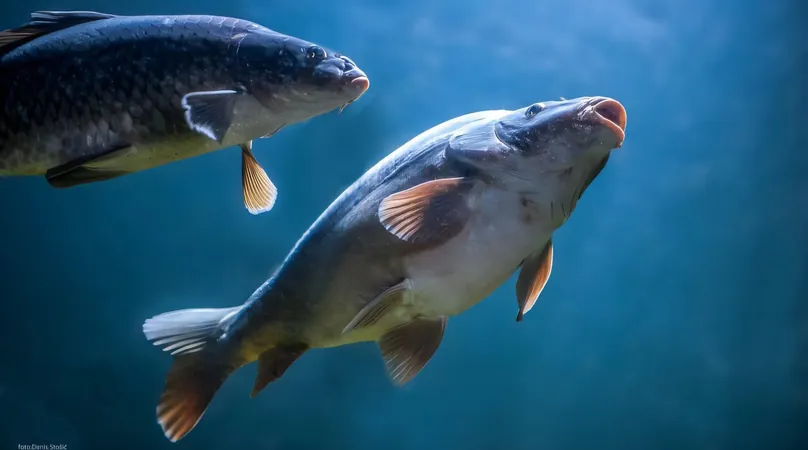
Unlocking the Secrets of Behavior: How a Tiny Worm is Revolutionizing Neuroscience
2025-01-21
Author: Charlotte
Unlocking the Secrets of Behavior: How a Tiny Worm is Revolutionizing Neuroscience
In the intricate world of neuroscience, the humble roundworm Caenorhabditis elegans, with its mere 302 neurons, is paving the way for groundbreaking discoveries. Researchers have meticulously mapped the connections of these neurons, revealing how they collaborate to drive the worm’s diverse behaviors.
Leading this fascinating research is Steven Flavell, an associate professor at MIT’s brain and cognitive sciences department and an investigator at the renowned Picower Institute for Learning and Memory. Flavell’s research focuses on motivated behaviors, particularly feeding and navigation, with the overarching goal of uncovering fundamental principles that govern similar behaviors across species.
Recent investigations from Flavell’s lab have illuminated the neural mechanisms behind the adaptive feeding strategies of these worms. By analyzing how individual neuron activity influences the worm's actions, researchers aspire to gain insights applicable to higher organisms, including humans. Flavell posits, “Our aim is to identify molecular and neural circuit mechanisms that may generalize across organisms.” This interdisciplinary approach builds on the historical foundations laid by C. elegans, where many pivotal biological discoveries—ranging from programmed cell death to microRNA—were first identified.
The fascinating journey of Flavell, who was born in London but moved to the U.S. at a young age, has been intertwined with science from the outset. Growing up in a family rooted in academia, his early passion for English and music gradually transformed into a profound interest in neuroscience during his time at Oberlin College. His initial foray into research on Alzheimer’s disease ignited a lifelong commitment to scientific exploration. Flavell later honed his expertise at Harvard Medical School, where he focused on understanding how sensory experiences shape brain development through gene regulators critical to neurons.
Transitioning from mouse models to C. elegans during a postdoctoral fellowship, Flavell recognized the advantages of studying simpler organisms. The clear neuronal wiring of C. elegans—with a detailed map of roughly 7,000 synapses—offers unparalleled insights. In stark contrast, a single human neuron can form more than 10,000 synapses, making the complexity of human brains daunting to traverse.
Despite their simplicity, C. elegans exhibit remarkably intricate behaviors such as feeding, locomotion, egg-laying, memory formation, and mate selection. With neuromodulators and other cellular mechanisms comparable to those of humans, the research potential is immense. "Studying the defined behaviors of C. elegans allows us to measure and analyze nearly every aspect of their actions," Flavell emphasizes.
One of Flavell’s significant contributions has been elucidating the neural underpinnings of stable behavioral states in foraging worms. His work indicates that the transition between exploring and feeding behaviors is intricately influenced by environmental cues, hunger levels, and potential food sources. Central to this process are neuromodulators like serotonin, which regulate these states. Flavell's lab has produced an ‘atlas’ outlining the interactions of the serotonin systems in C. elegans, connecting the dots between neuron activity and behavior.
In a groundbreaking study in 2023, his team developed advanced microscopy techniques that enable simultaneous tracking of worm behavior and neuron activity, paving the way for computational models that precisely delineate how brain behavior correlates with neural activity. Such innovations highlight the multidisciplinary nature of Flavell’s lab, where expertise spans physics, biology, and computer science.
Flavell’s pursuit of a collaborative research environment has been realized at MIT, where his diverse team employs an array of tools and methodologies to further push the boundaries of neuroscience. “The integration of various disciplines allows us to achieve research outcomes that would be less feasible in a more traditional lab setting,” he concludes.
As the studies on C. elegans continue to unravel the complexities of neural behavior, the implications for understanding human neuroscience are vast. This tiny worm may hold the key to unlocking deeper mysteries of how our own brains function—proof that sometimes, the simplest organisms can lead to the most profound discoveries!









 Brasil (PT)
Brasil (PT)
 Canada (EN)
Canada (EN)
 Chile (ES)
Chile (ES)
 Česko (CS)
Česko (CS)
 대한민국 (KO)
대한민국 (KO)
 España (ES)
España (ES)
 France (FR)
France (FR)
 Hong Kong (EN)
Hong Kong (EN)
 Italia (IT)
Italia (IT)
 日本 (JA)
日本 (JA)
 Magyarország (HU)
Magyarország (HU)
 Norge (NO)
Norge (NO)
 Polska (PL)
Polska (PL)
 Schweiz (DE)
Schweiz (DE)
 Singapore (EN)
Singapore (EN)
 Sverige (SV)
Sverige (SV)
 Suomi (FI)
Suomi (FI)
 Türkiye (TR)
Türkiye (TR)
 الإمارات العربية المتحدة (AR)
الإمارات العربية المتحدة (AR)